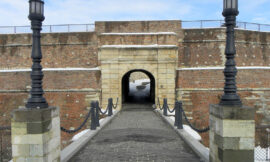Morpeth Castle, nestled in the charming market town of Morpeth in Northumberland, England, is a historic fortress that has stood as a symbol of strength and resilience for centuries. Although now largely in ruins, the castle’s imposing walls and turrets evoke a sense of medieval grandeur, offering visitors a glimpse into the region’s rich history and heritage.
Originally constructed in the 12th century by the de Merlay family, Morpeth Castle played a crucial role in defending the northern border of England against Scottish incursions during the Middle Ages. Strategically positioned on a bend of the River Wansbeck, the castle’s sturdy walls and formidable defenses made it a formidable stronghold, capable of withstanding sieges and attacks.
Over the centuries, Morpeth Castle passed through the hands of various noble families, each leaving its mark on the fortress in the form of renovations, expansions, and embellishments. The most significant alterations occurred during the 14th and 15th centuries when the castle was rebuilt and fortified in response to changing military tactics and technologies.
One of the most notable features of Morpeth Castle is its imposing gatehouse, which still stands as a testament to the castle’s former glory. This imposing structure, with its massive stone walls and fortified towers, once served as the primary entrance to the castle, protecting its inhabitants from would-be invaders and providing a symbolic gateway to power and prestige.
In addition to its defensive capabilities, Morpeth Castle also served as a residence for the local lord and his family, offering a comfortable and luxurious lifestyle befitting their status. The castle’s interior would have been adorned with tapestries, fine furnishings, and works of art, providing a glimpse into the opulence of medieval noble life.
Despite its turbulent past, Morpeth Castle eventually fell into disrepair and was abandoned in the 18th century. Today, only a few remnants of the original fortress remain, including the gatehouse and parts of the curtain walls, which have been partially restored and preserved for future generations to enjoy.
In recent years, Morpeth Castle has been transformed into a public park and garden, offering visitors a peaceful retreat amidst the hustle and bustle of urban life. The castle grounds feature landscaped gardens, meandering pathways, and panoramic views of the surrounding countryside, providing a perfect backdrop for picnics, leisurely strolls, and outdoor recreation.
In addition to its natural beauty, Morpeth Castle also hosts a variety of events and activities throughout the year, including guided tours, historical reenactments, and cultural festivals. These events offer visitors the opportunity to learn more about the castle’s fascinating history and explore its hidden corners, bringing the past to life in a vibrant and engaging way.
In conclusion, Morpeth Castle stands as a proud testament to the resilience and endurance of Northumberland’s medieval heritage, offering visitors a captivating glimpse into the region’s rich history and cultural legacy. With its imposing ruins, scenic surroundings, and vibrant community spirit, Morpeth Castle continues to inspire and enchant all who have the privilege of visiting this historic landmark.



